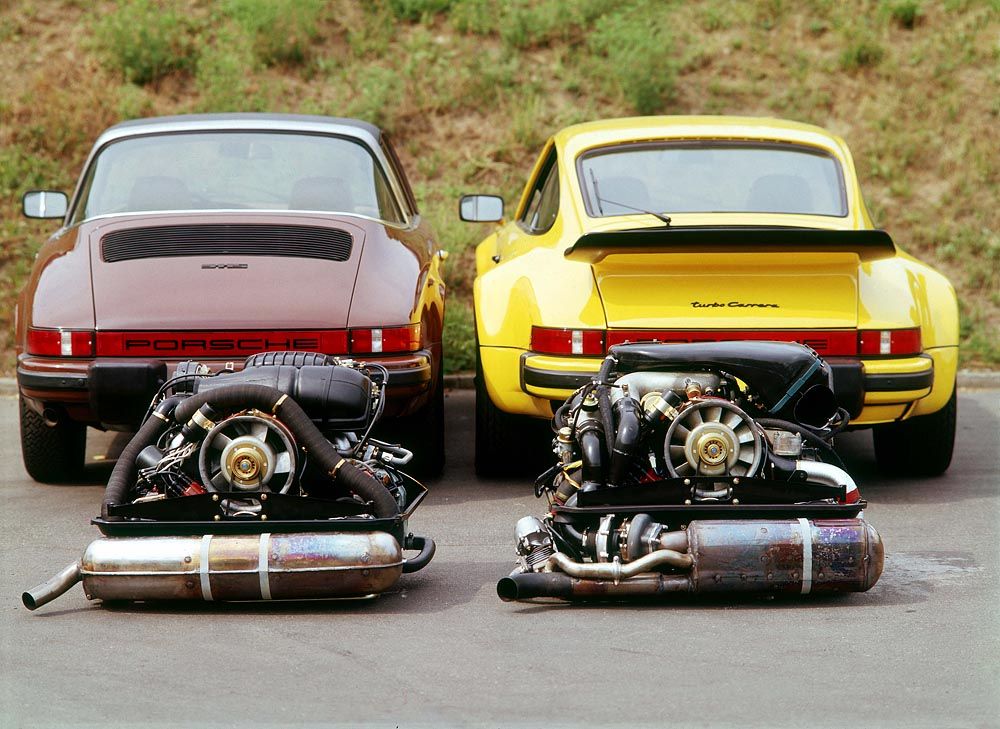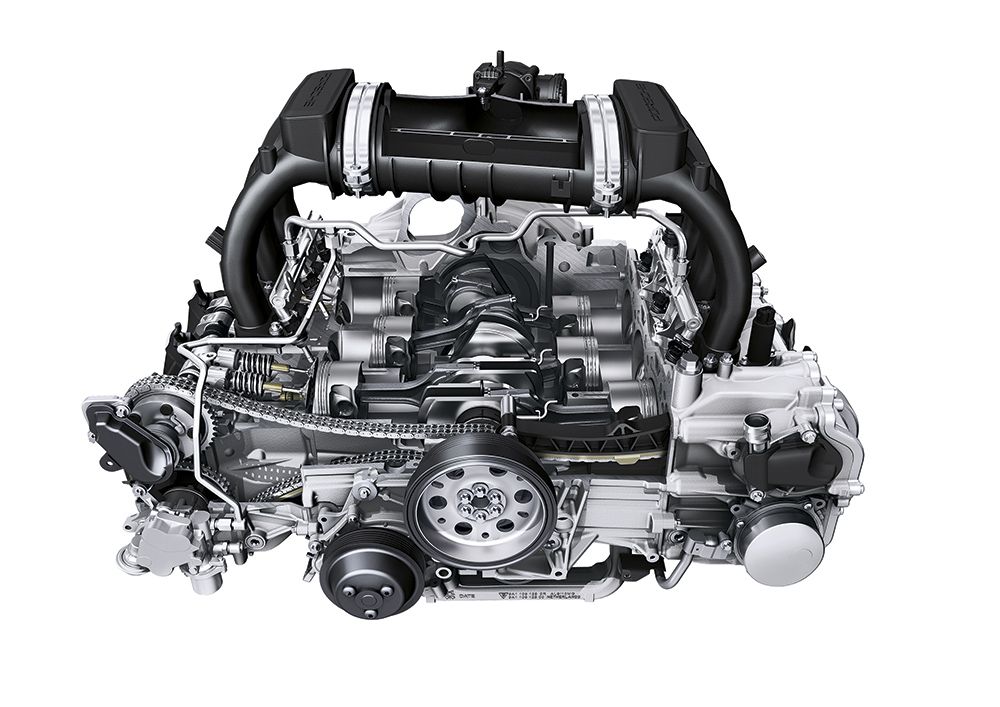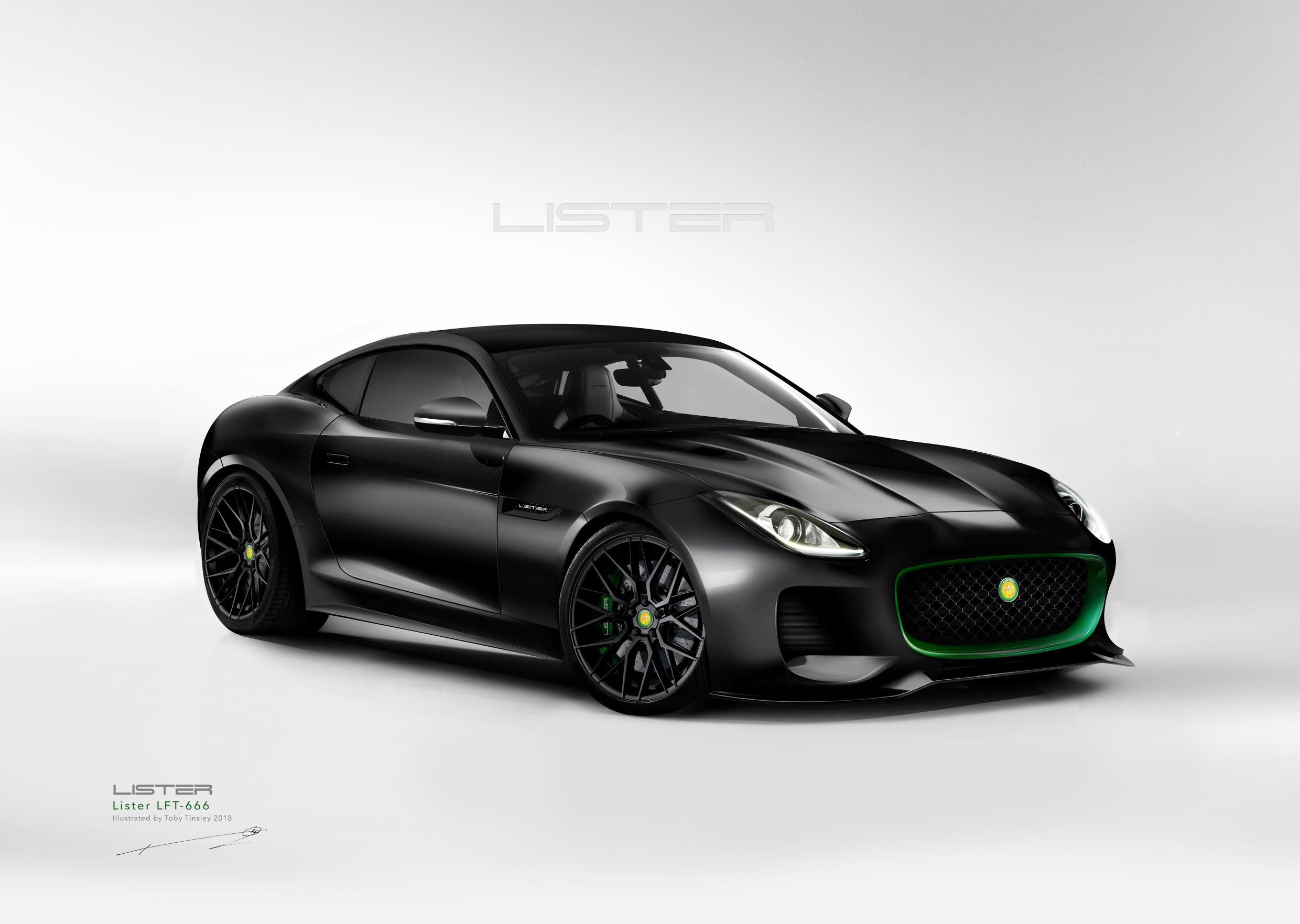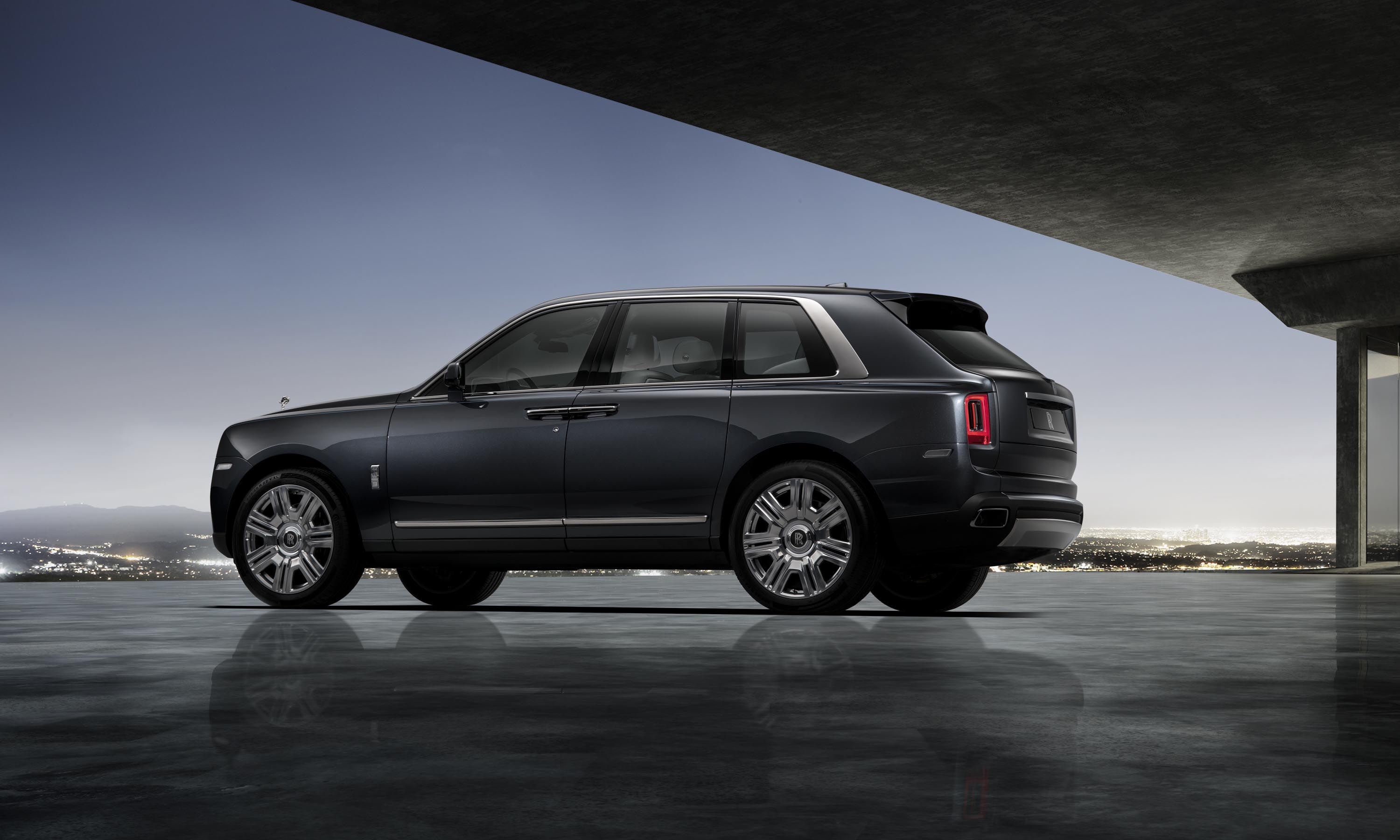EFFICIENCY AND PERFORMANCE FOR 50 YEARS: THE FLAT-SIX ENGINES FROM PORSCHE
11/6/2013, Stuttgart.- Once again, a flat-six engine from Porsche has been named “Engine of the Year”. This year, the international jury gave the renowned award to the 2.7-litre engine that is used in the Boxster and the Cayman for the 2.5 to 3.0-litre engine displacement class. “A brilliant engine for a brilliant car. This centrepiece of Porsche technology combines performance and a sporty pedigree with impressive fuel efficiency.” This is how Dean Slavnich of “Engine Technology International Magazine” supported the jury’s decision. The British trade magazine has been giving this award for excellent engines for 15 years now. The jury also praised the flexibility and responsiveness, performance and smooth running of the smallest-displacement flat engine from Porsche.
The sport engine was derived from the 3.4-litre engine based on the downsizing principle, and together with the PDK transmission (Porsche Doppelkupplung) in the Cayman it offers a power of 275 hp (202 kW) combined with a NEDC fuel consumption of 7.7 l/100 km (180 g/km CO2). Its specific power of 101.6 hp/l means that this six-cylinder engine surpasses the magic limit of 100 hp per litre engine displacement.
This is the fourth time that a flat engine from Porsche has won this competition between the best engines in the world. In 2007, Porsche has already won in the category of three to four-litre engines with the engine of the 911 Turbo. In 2008, the turbocharged 3.6-litre flat engine with 480 hp even won in the open displacement class. In 2009, the 3.8-litre six-cylinder engine of the 911 Carrera S was named “Best New Engine”. The choice of “Engine of the Year” is made by 87 highly regarded automotive journalists from 35 countries who evaluate the engines in various categories. Along with power, fuel economy, driving properties and comfort, the use of innovative technologies is also assessed.
Advantages: compact and light, high-revving and smooth – for 50 years
The 50 years of Porsche 911 also represents 50 years of the flat-six engine. Not simply for tradition sake, but because of its advantages: it is very flat, lightweight and compact. The flat engine with six cylinders is very smooth running, and it has neither free moments nor free forces of inertia. In addition, horizontally opposed engines are very well suited to lowering a vehicle’s centre of gravity. The horizontal cylinders enable very low-profile construction. And the lower a vehicle’s centre of gravity, the sportier it can be driven.
Another of the most prominent traits of the Porsche flat-six engines is their low fuel consumption in relation to their power. This excellent fuel efficiency is based on the overall concept that is influenced by motorsports. It is based on systematic lightweight design, high-revving and a large specific power as a result of its advantageous charge cycle.
These basic traits were crucial in the decision to develop a six cylinder engine with an opposing cylinder layout for the first 911. This resulted in an air-cooled flat-six engine with axial blower and – due to its higher rev reserves and improved smooth running – one overhead camshaft per side. At first, the displacement was specified as two litres, and the engine was designed for potential increases up to 2.7 litres. In those days, no Porsche engine specialist could have predicted that this engine type would be continued in its basic form right up to the year 1998 and would finally reach 3.8 litres of displacement.
World premiere in 1963 with 130 hp from two litres of displacement
At the world premiere of the 911, which was initially known as the 901 at the Frankfurt Motor Show (IAA) in 1963, the flat-six engine produced a power of 130 hp at 6,100/min from its two litres of displacement. The success of the new sports car quickly led to customer wishes for more power. Porsche responded, and the 911 S made its debut in model year 1967 with 160 hp at 6,600/min – the base model was soon designated the 911 L, and later the 911 E. At that time, the engineers were especially proud that despite the added power and a power-to-displacement ratio of 80 hp per litre, there were no compromises in terms of engine life.
The 911 not only established itself on the world market based on its efficient performance, but also by its technological progress. In 1968, Porsche offered the sports car with an emissions control system for the USA. A special aspect of this system: Porsche was able to satisfy US emissions regulations – including the especially stringent rules for California – without any compromises in performance and with nearly identical driving comfort. Hazardous emissions were controlled by exhaust gas recirculation in the induction manifold and by thermal reactors. In its development work, Porsche was the first company in Europe to ever install roller dynamometers for emissions testing.
In autumn 1968, Porsche introduced mechanical petrol injection with six-piston pump. In addition to increasing displacement, it also added more power and torque. In 1969, the six-cylinder engine first grew to 2.2 litres, then two years later to 2.4 litres. This resulted in 180 hp of power for the 911 S at first and then 190 hp. In 1971, engine compression was reduced so that all 911 cars could be powered by regular petrol worldwide. In close cooperation with Bosch, Porsche developed the K-Jetronic – an improved, continuous fuel injection system, which was first introduced in the US models in 1972.
In 1974, the 911 Turbo made its debut as the first production sports car with a turbocharger
In 1973, all engines in the 911 generation designated as “G models” were converted to engine displacements of 2.7 litres, and operation with unleaded regular petrol was made possible – here Porsche proved once again that sports cars could be eco-friendly. In 1974, a legend made its first appearance: Porsche introduced the 911 Turbo, the first production sports car with a turbocharger. In this car, engineers transferred their extensive experience with turbocharged engines from motorsport into series production. The engine was based on the engine of the 911 Carrera RS 3.0 which produced 260 hp and a torque of 343 Newton metres which took the car to a top speed of over 250 km/h.
Advanced development of the six cylinder engine brought displacement and power enhancements over several stages, combined with highly advanced emissions control technology. Porsche built the first flat engines with regulated catalytic converters in 1980. Three years later, a new generation of naturally aspirated engines was presented, which had 3.2 litres of displacement and digital engine electronics. All of the engines were now designed for unleaded regular petrol – in many European countries this fuel was still unavailable, but the engine design offered flexibility. In 1988, Porsche made further improvements to the combustion process and developed a cylinder head with two spark plugs per combustion chamber.
The air-cooled flat engine reached its zenith with the naturally aspirated engine of the 993 model series, which produced 300 hp from 3.8 litres of displacement in the top model 911 Carrera RS in 1995. There was a limited edition series of the 911 GT2, a car derived from motorsport, whose 3.6-litre engine first developed 430 hp with the help of two turbochargers and then 450 hp in model year 1998. The 911 Turbo also adopted the biturbo concept, and another global innovation was the OBD II emissions control monitoring system. The now 408 hp engine was still based on the naturally aspirated 3.6-litre engine, but it had been modified so extensively that it was considered an independent design.
In 1996, the first water-cooled flat-six engine from Porsche celebrated its world premiere
The engine of the new Boxster model series represented a quantum leap in the development history of the flat-six engines from Porsche at its world premiere in 1996. For the first time, Porsche implemented a water-cooled engine that had 2.5 litres of displacement and 204 hp of power. Freed of the restrictions of the previous six cylinder engine with air cooling, engine developers gave the new engine a cylinder head with two camshafts and four valves per cylinder. One year later, the new 911 of the 996 model series appeared, also with a water-cooled engine. The engine with 3.4 litres of displacement was significantly shorter and above all flatter than the previous model. It produced 300 hp and was much higher revving than the previous engine. In addition, the intake camshaft was adjustable, and the VarioCam variable valve timing adjustment concept was born. Two years later, this system was supplemented by valve lift adjustment, and since then it has been named VarioCam plus. However, its key data were unchanged: six cylinders, seven-bearing crankshaft, dual-mass flywheel and a longitudinally split engine housing. The 911 Turbo was also changed over to water cooling, and in the year 2000 it got a new engine with 420 hp. Once again, displacement and power were boosted over the course of time, and by the middle of the 2000 decade, flat engines with 3.6 and 3.8 litres of displacement and 355 hp were added.
In 2008, the 911 Carrera and 911 Carrera S models then got engines with direct fuel injection that had been designed from the ground up. They produced 345 hp and 385 hp from the same displacement. Also coming from this engine family were the engines used in the Boxster and Cayman. Starting around 2008, “downsizing” with the goal of better fuel efficiency became a trendsetting objective for powertrain engineers. Based on its bundled knowledge, Porsche developed the new technology for the 911 of the 991 model series, which appeared in 2011. For example, the flat engine in the 911 Carrera with 350 hp had a displacement of 3.4 litres instead of the previous 3.6 litres. The 400 hp Carrera S retained its 3.8 litres of displacement. Both models illustrate how the 991 model series was developed into a complete package designed for maximum fuel efficiency. With a weight to power ratio of 3.5 kilograms per hp, the new 911 Carrera S is at the top of the field. And in terms of its NEDC fuel consumption, the 911 Carrera posts a value of 8.2 litres per 100 km (194 g/km CO2) and the 911 Carrera S a value of 8.7 l/100 km (205 g/km CO2) – both with PDK – these too are excellent values.
In the segment of two-seat roadsters and coupés, the Boxster and Cayman make their appearance with the same positive traits that have now also led to recognition of the 2.7-litre engine as “Engine of the Year” in its displacement class. In the Boxster, the engine produces 265 hp with fuel consumption values identical to those of the Cayman engine. The Boxster S and Cayman S are equipped with a 3.4-litre variant; in the roadster it produces 315 hp and in the sport coupé its power is boosted to 325 hp. Equipped with PDK, both engines have combined NEDC fuel consumption values of 8.0 l/100 km (188 g/km CO2).
Here, Porsche is making a clear statement: the six-cylinder flat engine is not an engine of yesterday. Rather, it is the foundation for development of the efficient sports engine of tomorrow.
Porsche Boxster/Cayman: Fuel consumption: urban 12.2 – 10.6 l/100 km; extra-urban 6.9 – 5.9 l/100 km; combined 8.8 – 7.7 l/100 km; CO2 emissions 206 – 180 g/km.
More information:
Text and photographs by: Porsche












